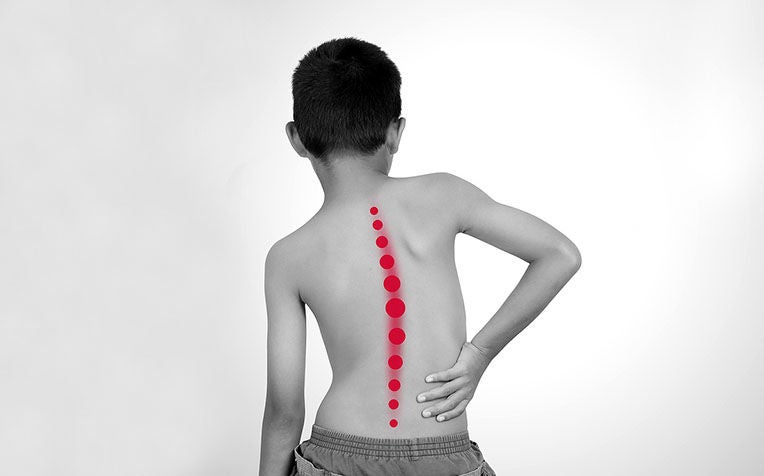
Scoliosis when viewed on an X-ray, shows the spine curved like an “S” or a “C” shape rather than a straight line.
Does your child have uneven shoulders, with one shoulder appearing higher than the other? Or an oddly curved spine that looks like the alphabet S?
These are some of the symptoms of
scoliosis, a medical condition commonly affecting children and adolescents, particularly girls.
The prevalence of scoliosis is the highest during the growth spurt years, between the ages of 9 and 15. Scoliosis also affects adults, but is less common.
What is scoliosis?
In scoliosis, the normally straight spine curves from side to side due to a deformity in the bone. The deformity can be congenital, present from birth, or it can develop during the growing years. Most often, there is no known cause, and the condition is then called “idiopathic scoliosis”.
“Scoliosis is a deformity of the spine, and should not be confused with poor posture, which is generally associated with weak muscles of the spine,” explains
Dr Guo Chang Ming, Senior Consultant from the Department of Orthopaedic Surgery at Singapore General Hospital (SGH), a member of the
SingHealth group.
Types and causes of scoliosis
Idiopathic scoliosis: This most commonly affects children over the age of 10 when it is referred to as adolescence scoliosis. Idiopathic means its cause is unknown. It has been known to run in families, but no responsible genes have yet been identified.
This type of scoliosis can also affect children below the age of 3 (infantile scoliosis) and children between 3-10 years (juvenile scoliosis). The most common age group is the adolescent age group.
In Singapore, the prevalence of idiopathic scoliosis in schoolgirls is 1.4 per cent at the age of 11-12 and 2.2 per cent at the age of 13-14.Congenital scoliosis: Present at birth and caused by a bone abnormality.
Neuromuscular scoliosis: Caused by an abnormality in muscles or nerves, and commonly seen in patients with spina bifida or cerebral palsy.
Degenerative scoliosis: Occurs later in life and may result from injury to bone or degeneration of joints found in conditions such as arthritis or osteoporosis.
“Scoliosis is not caused by carrying heavy objects, such as heavy school bags, strenuous sports, poor posture, or a lack of calcium and other nutrients in the diet,” says Dr Guo.
“Though the cause of idiopathic scoliosis is by definition unknown, it may have a genetic basis since it is known to run in families.”
Signs and symptoms of scoliosis
Abnormal curving of the spine which appears as an S or C shape
Uneven shoulders or a prominent shoulder blade
Uneven hips
Uneven waist, with a tilt to one side
In adult females, there may be uneven breasts with one breast appearing higher
Treatment for scoliosis
The treatment for scoliosis depends on the age of the patient, the severity of the spine condition, and the cause.
Most patients with idiopathic scoliosis who have a curvature that is less than 25 degrees, don’t need treatment. These patients will simply need to be observed at regular intervals of 4-6 months. Observation involves a physical examination and an X-ray.
“Children whose self-esteem is affected because of scoliosis, may need counselling support in addition to the normal treatment procedures,” Dr Guo adds.
For significant cases of scoliosis, treatment options include:
Braces: These body braces are prescribed for children whose bones are still growing. The child will have to wear the brace continuously for one or two years to halt the progression of the spinal curve. The brace will not reduce the curvature that is already present. In adult patients, braces are recommended for short periods, such as when they are doing manual work. Long-term use for adults can cause the spine to stiffen and the back muscles to weaken.
Surgery: Surgery may be required if the scoliosis continues to progress despite the braces. Patients who have a spine curvature of 40-50 degrees may be recommended spinal fusion surgery. This involves a bone graft to permanently fuse the vertebrae. Metal rods, hooks and screws are used to hold the bones in place until they fuse.
One drawback of this fusion process for children is that the bones that are joined together stop growing – hence this surgical procedure is used as a last resort for children and adolescents who still have some growth years left.
“Back braces will not help patients with congenital scoliosis or those with neuromuscular scoliosis. Congenital scoliosis is also difficult to treat with surgery and may require multiple operations,” says Dr Guo.
Complications of scoliosis
In severe cases, the rib cage may press against the lungs and heart causing complications such as:
Breathing problems
Lung and heart damage
Nerve damage
Persistent back pain
Scoliosis cannot be overcome by correcting posture. Food, vitamin supplements and exercise programmes have also not been found to be helpful in treating the condition or halting its progression. However, scoliosis patients are advised to stay fit and active for a better prognosis.
“If patients get appropriate treatment for scoliosis at an early stage, they can go on to lead normal lives,” says Dr Guo.
Ref: H24 (ed)
Articles related to childhood conditions:
Children's Fever: What to Do and When to See a Doctor
Tips to Manage Children's Asthma
Contributed by















 Get it on Google Play
Get it on Google Play